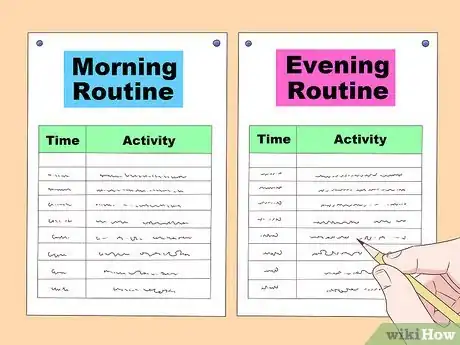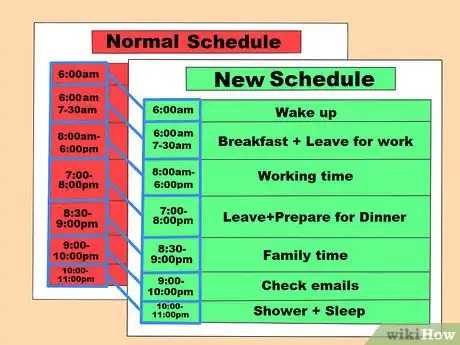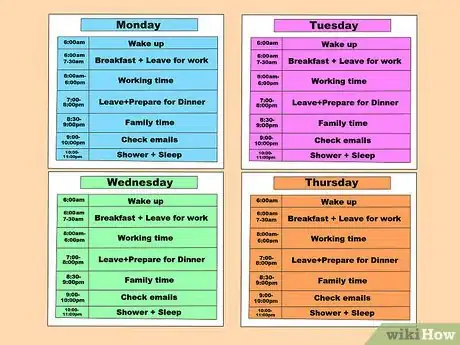This article was co-authored by Michelle Shahbazyan, MS, MA. Michelle Shahbazyan is the Founder of The LA Life Coach, a concierge life, family, and career coaching service based in Los Angeles, California. She has over 10 years of experience with life coaching, consulting, motivational speaking, and matchmaking. She has a BA in Applied Psychology and an MS in Building Construction and Technology Management from Georgia Tech University, and a MA in Psychology with an emphasis on Marriage and Family Therapy from Phillips Graduate University.
There are 8 references cited in this article, which can be found at the bottom of the page.
This article has been viewed 141,256 times.
If you’re looking to be more productive, or just bring a little more consistency into your life, a routine may be the thing for you. Routines can be fun, help keep you organized, and make you much more efficient with your time. By determining what the goals for your routine are, scheduling your routine during a set time and keeping to it, and following your routine one step at a time, you can quickly and easily incorporate a daily routine into your life.
Steps
Setting Up Your Routine
-
1Write down your daily activities to figure out what to put in your routine. If you already have tasks you need to do each day (e.g., take medication) or if there are things you want to start doing each day, jot these down in a list and use it to plan out your routine. Try to lump together tasks that work toward the same goal.[1]
- For example, if your goal is to have a productive morning routine, then you should only lump together tasks you can accomplish in the morning and that make you more productive (e.g., taking your medication, responding to emails).
- It may be easiest to lump tasks together by time (e.g., morning tasks, evening tasks) rather than by purpose.
-
2Set a goal for your routine. Do you want your routine to make you more productive? To get fit? To live a healthier life? Before you can go about creating your routine, you’ll need to know what you want that routine to eventually accomplish.[2]
- For example, if your goal is to live a healthier life, you may want to craft a routine that helps you to get more sleep at night or that lets you cook healthier meals for yourself.
- The goal of your routine may also determine when in your day you’ll follow your routine. For instance, many people follow exercise routines in the morning because that’s when their energy levels are highest.
Find your motivation. "To sustain a routine, I know I have to be self-motivated. This involves incorporating activities that I place value on for myself, not for anyone else. When deciding on a routine, I look for something that's going to make me feel physically and mentally better at the end of it. If I can say yes to that it doesn't matter how I got there, or what the outcome is. The important part is the process. For me, that's the mental shift it takes to take something from being a burden into being enjoyable. You have to motivate yourself to keep a routine by including activities that you can directly tell are positive and additive for you." Talia, 26 year-old
Advertisement -
3Create a daily to-do list to structure your routine. Many people find it useful to write down the daily tasks they set out for themselves; this will serve as a constant reminder of your routine and also give you the satisfaction of being able to cross completed items off the list![3]
- If you want to follow a strict routine, you can also list the time you want to complete each task at (e.g., “7:30-eat breakfast. 8:00-leave for work.”). If you want to leave more room for spontaneity, simply write down your daily tasks in the order you want to complete them in.
-
4Break tasks into smaller chunks that are easier to achieve. If you’re just starting a new routine, the tasks in your routine will seem much easier to achieve when you break them into smaller mini-tasks. Divide each task into its component parts and accomplish each mini-task 1 at a time.[4]
- For example, if your weekly routine involves cleaning your apartment, then rewrite that task into smaller tasks like vacuuming the carpet, dusting the furniture, and cleaning the bathroom.
- If a task takes too long, break it into smaller tasks that will give you a feeling of accomplishment more quickly to keep you motivated.
Scheduling Your Routine
-
1Set aside a regular time in which to carry out your routine. Once you’ve decided what you want your routine’s goal and makeup to be, you need to figure out when you can fit your routine’s activities in your day. Carve out a chunk of your normal schedule and devote that time to following your routine.[5]
- If possible, devote more time to each individual task than you think you’ll actually need; for example, if exercising typically takes you 40 minutes, plan to devote 1 hour to the task. This will help prevent you from becoming too stressed while following your routine every day.
- Make time for your routine even on your busy days. Most routine tasks can be accomplished in a small amount of time (e.g., making your bed, taking medication, eating breakfast) and you’ll feel more accomplished if you take the time to cross them off your to-do list.
-
2Perform your routine at the same time each day to be most consistent. For long-term consistency, consider committing a distinct bloc of time (e.g., from 7:30 to 8:00) to your routine each day. However, if your everyday schedule is more fluid, simply commit to devoting some amount of time each day to your routine.[6]
- For example, if your schedule doesn’t allow you to stick to a set time for your routine (e.g., 7:30-8:00), just make sure you’re spending 30 minutes each day on your routine tasks. Just because you’re following a routine doesn’t mean you can’t be flexible.
-
3Plan out your routine on a longer time-scale. Decide what needs to be done daily, weekly, biweekly, monthly, yearly, etc. and schedule this all out. You’ll need to follow your routine over a long period of time and mapping it out will make it easier for you to plan out your activities as needed.[7]
- Purchase a calendar or agenda if you need to, as this will help you to begin managing your time more wisely. A written, scheduled routine will be a lot easier to insert into the day-to-day or weekly things that need to be done.
- Try to plan out your routine for at least 3 weeks; this is generally how long it takes for your routine to become a normal habit for you.
Following and Tweaking Your Routine
-
1Follow your routine consistently for 3 weeks to make it a habit. It generally takes 21 days for an activity to become an ingrained habit. Make sure you consistently do your routine tasks every day for 3 weeks to get fully accustomed to your new routine.[8]
- You will probably still form a habit after 21 days if you miss 1 day somewhere in those 3 weeks. However, if you find that you skip your routine on 2 or more days, consider redesigning your routine to make it easier for you to accomplish every day.
- Once you start doing the activities in your routine without thinking, then you’ve successfully formed a habit!
-
2Forgive yourself when you slip up. You’ll probably make a mistake or slip up in implementing your routine at some point. Instead of berating yourself, give yourself some leeway to accomplish only some or even none of your routine for that day, then set out to be successful the next day.[9]
- For example, if part of your workout routine involves doing 40 pushups, don’t beat yourself up if you only do 20 during 1 workout. Instead, recognize that you still accomplished part of what you set out to do and try to do better next time.
- Don’t give up on your routine if you fail early on; it will get easier over time.
-
3Keep track of your progress to gauge whether your routine is working. At the end of each week, check in on your progress towards your goals and see whether your routine is helping you reach those goals. If it isn’t, consider what aspects of your routine might need improvement.[10]
- For example, if the purpose of your routine was to make you more productive in the mornings, look back over your week and see how many times you’ve arrived to work earlier or later than usual. If your routine has made you get to work earlier every day, that’s a good sign that it’s making you more productive in the mornings.
- For more long-term goals (e.g., losing weight), it might be better to check in with your routine at the end of each month.
-
4Make changes to your routine as needed. Once you’ve designed your routine and have had time to test out, don’t be afraid to go back and make tweaks over time. Whether you want to add or subtract tasks or recalibrate your activities for a new goal, treat your routine as a fluid and ever-changing list.[11]
- For example, if you find that your workout routine has gotten too easy, consider going back and adding more difficult exercises into the mix.
Expert Q&A
-
QuestionWhat is an ideal daily routine?
 Michelle Shahbazyan, MS, MAMichelle Shahbazyan is the Founder of The LA Life Coach, a concierge life, family, and career coaching service based in Los Angeles, California. She has over 10 years of experience with life coaching, consulting, motivational speaking, and matchmaking. She has a BA in Applied Psychology and an MS in Building Construction and Technology Management from Georgia Tech University, and a MA in Psychology with an emphasis on Marriage and Family Therapy from Phillips Graduate University.
Michelle Shahbazyan, MS, MAMichelle Shahbazyan is the Founder of The LA Life Coach, a concierge life, family, and career coaching service based in Los Angeles, California. She has over 10 years of experience with life coaching, consulting, motivational speaking, and matchmaking. She has a BA in Applied Psychology and an MS in Building Construction and Technology Management from Georgia Tech University, and a MA in Psychology with an emphasis on Marriage and Family Therapy from Phillips Graduate University.
Life Coach It depends on your goal. When you want to create an effective daily routine, start by figuring out what the ultimate goal is, then work backwards from there. For instance, if your goal is to be motivated first thing in the morning, you might start by setting an early alarm and making your bed as soon as you get up. As you achieve those steps, it will be even easier to set bigger and bigger goals.
It depends on your goal. When you want to create an effective daily routine, start by figuring out what the ultimate goal is, then work backwards from there. For instance, if your goal is to be motivated first thing in the morning, you might start by setting an early alarm and making your bed as soon as you get up. As you achieve those steps, it will be even easier to set bigger and bigger goals.
Warnings
- If you find you have trouble in getting rid of bad routines and habits, seek help from a professional or talk to your friends and work out the problems.⧼thumbs_response⧽
References
- ↑ https://mhanational.org/sites/default/files/Handout%20-%20Creating%20Healthy%20Routines.pdf
- ↑ https://mhanational.org/sites/default/files/Handout%20-%20Creating%20Healthy%20Routines.pdf
- ↑ https://hbr.org/2021/01/i-tried-4-to-do-list-methods-heres-what-worked
- ↑ https://news.uga.edu/break-large-tasks-down-into-smaller-more-manageable-pieces/
- ↑ https://hbr.org/2021/01/i-tried-4-to-do-list-methods-heres-what-worked
- ↑ https://www.northshore.org/healthy-you/how-to-start-a-new-routine-and-stick-to-it/
- ↑ https://raisingchildren.net.au/grown-ups/family-life/routines-rituals-relationships/family-routines
- ↑ https://raisingchildren.net.au/grown-ups/family-life/routines-rituals-relationships/family-routines
- ↑ https://keeperofthehome.org/getting-back-into-a-routine-when-youve-gotten-off-track/
About This Article
To have a routine, start by identifying what you want to accomplish with your routine, whether that's being more productive in general or something specific like getting physically fit, so you can tailor your routine to that goal. Next, make a list of your daily activities and tasks, then break larger tasks into smaller chunks that are easier to achieve. Set aside a regular time frame for your routine and try to perform tasks at the same time each day. Then, follow your new routine consistently for 3 weeks to make it a habit! For tips on tracking your progress and tweaking your routine, read on!














-Step-16-Version-4.webp)



















-Step-16-Version-4.webp)



































